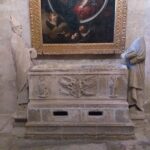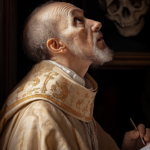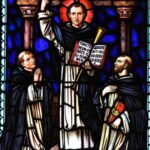St. Moses
St. Moses
When They Lived:
St. Moses, also known as Moses the Black or Abba Moses, lived during the 4th century. His life spanned from approximately 330 AD to 405 AD.
Where They Lived:
Moses the Black resided in the region of Egypt, particularly in the desert wilderness surrounding the Nile Delta. He spent a significant portion of his life as a monk in the Nitrian Desert, which was a hub of Christian monasticism during that era.
Notable World Events During Their Life:
- Council of Nicaea (325 AD): Moses the Black lived during a time when the early Christian Church was grappling with theological disputes. The Council of Nicaea in 325 AD was a significant event that addressed the nature of Christ’s divinity and formulated the Nicene Creed, shaping the foundations of Christian belief.
- Fall of the Western Roman Empire (476 AD): Moses’s life coincided with the decline of the Roman Empire. In 476 AD, the last Roman emperor was overthrown, marking the end of the ancient Western Roman Empire and ushering in the medieval period in Europe.
- Invasion of the Huns (375-454 AD): The migration and invasions of the Huns, a nomadic warrior culture, had a profound impact on the Eastern Roman Empire and its neighboring regions during Moses’s lifetime. These events reshaped political dynamics and territorial boundaries.
- Life of St. Augustine (354-430 AD): While not a contemporary of Moses, the life and writings of St. Augustine of Hippo intersected with Moses’s era. St. Augustine’s influential theological works, such as “Confessions” and “City of God,” provided insights into the Christian thought of the time.
- Founding of Constantinople (330 AD): Moses the Black witnessed the founding of Constantinople (modern-day Istanbul) by Emperor Constantine the Great. This city’s establishment as the new Eastern Roman capital would have had political, cultural, and religious implications for the Christian world.
Their Patronage:
St. Moses the Black is recognized as the patron saint of those who have turned their lives around, seeking redemption and a path of spiritual transformation. His life story, marked by a dramatic conversion from a life of crime to one of asceticism and holiness, serves as an inspiring example of the power of redemption and the capacity for change.
Intriguing Narrative:
Moses the Black’s life is a remarkable journey from a life of crime to sainthood. Born into slavery in Africa, he escaped and became a feared bandit and criminal. However, a chance encounter with a group of monks in the desert led him on a path of self-discovery and spiritual awakening. Over time, Moses embraced monasticism and lived as a desert hermit, renowned for his wisdom, humility, and deep spirituality.
Early Life
Born in 330 AD in Ethiopia, Saint Moses is known by several names. The names he is also known for include Moses the Black, Abba Moses the Robber, the Ethiopian, and the Strong (Starodubcev, 2019).
He is highly respected in several branches of Christianity, including the Eastern Orthodox Church, the Oriental Orthodoxy, the Roman Catholic Church, the Eastern Catholic Churches, the Anglican Communion, and Lutheranism (Starodubcev, 2019). The major shrine of Saint Moses is in Paromeos Monastery, Church of the Virgin Mary, in Scetes, Egypt.
Before his conversion to Christianity, Saint Moses worked as a government official in Egypt (Starodubcev, 2019). However, after being found guilty of theft and suspected of murder, Saint Moses was immediately dismissed from being a government official (Starodubcev, 2019). After a life of crime, what made Saint Moses turn to Christianity? Let’s read on and investigate further.
From Sinner to Ascetic
While attempting to rob someone in the early hours of the morning, a dog hindered Moses from succeeding in the robbery (Gasperetti, 1952). As a result of this, Moses swore vengeance on the owner of the dog. Moses then proceeded to swim down the river, close to the owner’s hut, with his weapons in his mouth (Gasperetti, 1952). Again, alerted by the dog,the owner hid away from Moses, and Moses became frustrated. In this moment of frustration, Moses proceeded to slaughter some of the sheep belonging to the owner (Gasperetti, 1952).
The owner immediately reported Moses to the local authorities, and Moses was soon on the run. Extremely tired, Moses sought refuge with monks in a colony in the desert, now called Scetes, near Alexandria in Egypt (Gasperetti, 1952). Moses soon became heavily influenced by the monks and their ways of life, especially their dedication, peace, and commitment to their faith. As a result of this, Moses decided to turn a new leaf and soon became a Christian (Gasperetti, 1952). After a few months of learning the teachings of the monks, Moses was baptized and joined the monastic community in Scetes, becoming a notable desert father. The Desert Fathers, in the Christian faith, were the first early Christian hermits, monks, and ascetics (Gasperetti, 1952). They lived mainly in the desert in Scetes, Egypt, around the third century AD.
Life as a Monk in the Monastic Community
Moses struggled greatly with adapting to the monastic life he found himself in (Sister Felicity, 1964). The main reason for this The sense of adventure within Moses remained with him. One night, Moses was brutally attacked by a group of robbers in his desert cell (Sister Felicity, 1964). Moses fought back and took the robbers to the chapel,where other brothers in the monastery were busy with their prayers. After much discussion, the robbers repented for their sins and soon joined the community, becoming brothers later (Sister Felicity, 1964).
Moses believed he was not perfect enough to be a monk until one morning, when the abbot of the monastery spoke to him. He lifted Moses hopes of becoming a monk (Sister Felicity, 1964). It was from this day on that Moses proved himself and found that he was effective as a prophetic and spiritual leader. One notable moment in which this can be seen is when a fellow brother committed a fault and Moses was called to attend a meeting to discuss an appropriate penance for the brother (Sister Felicity, 1964).
Moses refused to attend this meeting, and when called to another meeting regarding the same subject matter, Moses took a leaking jug filled with water on his shoulder to the meeting. Upon arrival, the brothers questioned Moses about the leaking jug (Sister Felicity, 1964). Moses proceeded to explain to the brothers that his sins are unseen by him behind him, but he is here to judge the sins of another brother. After Moses said this, the other brothers forgave the monk.
Soon after this, Moses became the spiritual leader of the hermits in the Western Desert (Sister Felicity, 1964). He led them with pride in his heart, and soon he was ordained as a priest.
Death
Saint Moses passed away at the age of 75 years old in 405 AD (Kravchenko, 2021). He passed away in the Natron Valley, Egypt. This was following an attack on the monastery by a group of Berbers. Instead of taking up weapons, Saint Moses decided to remain behind and was joined by seven other brothers in a violent death by the robbers (Kravchenko, 2021). Together, they were martyred by the bandits, and their legacy lives on.
Today, St. Moses is celebrated as the saint of Africa and non-violence.
5 Interesting Facts About St. Moses
- Saint Moses is known as a man of peace for his humility and
example set by repenting for the awful crimes he committed while being
a bandit - During his ministry, Saint Moses called people to reconciliation.
and forgiveness by word and example - Before becoming a Christian, Saint Moses was the leader of a gang of
bandits that roamed the Nile Valley, spreading terror and violence.
wherever they could. - Saint Moses was trained by Abba Isidore the Priest to become a
monk and later, an ordained priest - Saint Moses started out his life as a slave in the home of an
Egyptian governor.
Prayer to St. Moses
Almighty God, whose blessed Son guides our footsteps in the way of peace: Deliver us from paths of hatred and violence, that we, following the example of your servant Moses, may serve you with singleness of heart and attain to the tranquility of the world to come, through Jesus Christ our Lord, who lives and reigns with you in the unity of the Holy Spirit, one God, now and forever. Amen.
Reference List
Starodubcev, T. (2019). St. Moses, the Ethiopian or the black Cult and representation in the Middle Ages Zograf, pp. 1–22. DOI:10.2298/ZOG1943001S.
Gasperetti, E. (1952) Saint Moses the Black, Negro History Bulletin, 15(8), 167–169. Retrieved August 2, 2021, from [http://www.jstor.org/stable/44212567] {.ul}.
Sister Felicity (1964) St. Moses the Black Life of the Spirit (1946–1964), 19 (214), 36–38 Retrieved August 2, 2021, from [http://www.jstor.org/stable/43706454] {.ul}
Kravchenko, E.V. (2021). The Matter of Race: The Brotherhood of St. Moses the Black and the Retelling of African American History through Orthodox Christian Forms Journal of the American Academy of Religion, 89(1), pp. 298–333. DOI:[https://doi.org/10.1093/jaarel/lfab025] {.ul}



